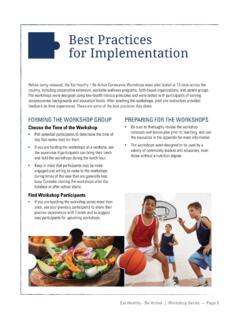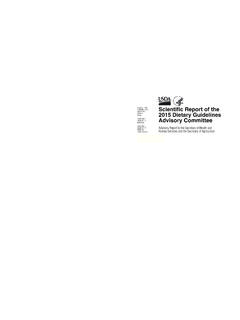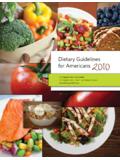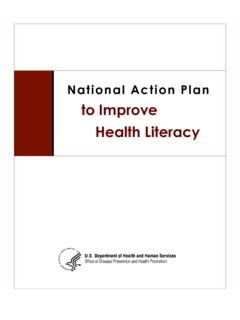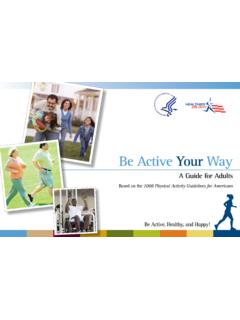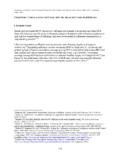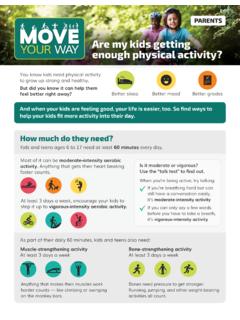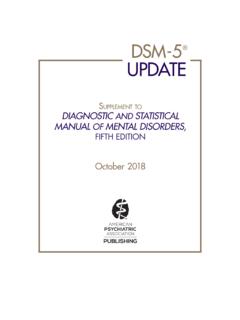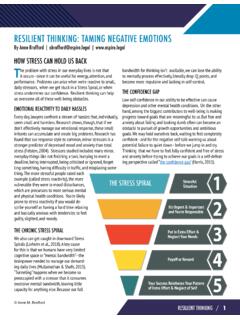Transcription of GUIDELINES FOR AMERICANS Healthy Eating Pattern 2015 …
1 2015 2020 Dietary GUIDELINES for AMERICANS How to Build a Healthy Eating Pat tern Page 1 DIETARY GUIDELINES 2015 -2020 EIGHTH EDITION FOR AMERICANS How to Build a Healthy Eating Pattern There are many different ways to eat Healthy . You can eat Healthy in a way that works for you and your family. Healthy Eating can fit all tastes and traditions and can be affordable, too. The key is to build a Healthy Eating Pattern , which means choosing a variety of nutritious foods in the right amounts for you and making these choices part of your everyday routine. Follow these tips based on the 2015 2020 Dietary GUIDELINES for AMERICANS for making choices that can help you reach or keep a Healthy body weight, get the nutrients you need, and lower your risk of health problems like heart disease, type 2 diabetes, and some types of cancers. Get a variety of nutritious foods and beverages. Eating a variety of foods and beverages is important.
2 It helps you get the range of nutrients you need to be Healthy . Eat a mix of foods across all food groups. Choose foods and beverages from all food groups vegetables, fruits, grains, dairy, and proteins not just 1 or 2 of them. Vegetables Fruits, especially whole fruits Grains, especially whole grains Fat-free and low-fat dairy, including milk, yogurt, cheese, and fortified soy beverages Protein foods, like seafood, lean meats and poultry, eggs, legumes (beans and peas), nuts, seeds, and soy products Eat a mix of foods within each food group. For example, each week try Eating several types of vegetables, including dark green, red and orange, starchy ones, legumes, and others. Switch up the protein foods you eat, too for example, consider fish, black beans, and peanut butter, not just lean meats and poultry. Try to eat and drink the right amounts for you. How many calories you need to eat depends on your age, sex, height, weight, and how active you are.
3 Use the MyPlate Daily Checklist at to find a plan that is right for you. Limit foods and beverages higher in saturated fats, added sugars,and sodium. Aim to get: Less than 10% of calories each day from saturated fats Foods higher in saturated fats include butter, cheese, whole milk, meats higher in fat (like beef ribs, sausage, and some processed meats), poultry skin, and tropical oils like coconut and palm oil. Instead, go for foods with unsaturated fats like seafood, avocados, most nuts, and canola or olive oil. Less than 10% of calories each day from added sugars Added sugars are syrups or other sweeteners with calories that are added to foods and drinks when they re being made or prepared. Stick mostly to foods and drinks with naturally occurring sugars like ones in unflavored milk and fruits or no sugar at all. Choose water instead of sugary drinks and limit sweet treats like cake, cookies, brownies, and candy.
4 Less than 2,300 milligrams of sodium each day for adults and children ages 14 and up (less for younger children) Sodium comes from table salt but most of the sodium we eat comes from foods that are packaged or served in restaurants. When buying foods in the store, check the Nutrition Facts label and choose the option with the lowest amount of sodium. To cut down on sodium, cook more at home or ask not to have salt added to your meal when Eating out. Small changes = big benefits Small shifts in your daily Eating habits can improve your health over the long run. For example, try swapping out white bread for whole-wheat bread and reach for a handful of nuts instead of potato chips. 2015 2020 Dietary GUIDELINES for AMERICANS How to Build a Healthy Eating Pat tern Page 2 Stick with it. A lifetime of Healthy Eating can help prevent health problems like obesity, heart disease, type 2 diabetes, and some types of cancer.
5 Think of every day and meal as an opportunity to make a Healthy choice. Want to learn more about how to find a Healthy Eating Pattern that works for you? Check out for more information on the Dietary GUIDELINES and find recipes for Healthy meals at Limit Fruits Grains Vegetables Dairy Oils Protein What s in a Healthy Eating Pattern ? The 2015 2020 Dietary GUIDELINES has recommendations for a Healthy Eating Pattern . For someone who needs 2,000 calories a day, a Healthy Eating Pattern includes: Fruits, especially whole fruits 2 cups A variety of vegetables dark green, red and orange, starchy, legumes (beans and peas), and other vegetables 2 cups Fat-free or low-fat dairy, including milk, yogurt, cheese, and/or fortified soy beverages 3 cups Grains, at least half of which are whole grains 6 ounces A variety of protein foods, including seafood, lean meats and poultry, eggs, legumes (beans and peas), soy products, and nuts and seeds 5 ounces Oils, like canola and olive oil or foods that are sources of oils, like nuts and avocados 5 teaspoons And it has limits on.
6 Saturated and trans fats limit saturated fats to less than 10% of daily calories and keep trans fat intake as low as possible Added sugars limit to less than 10% of daily calories Sodium limit to less than 2,300 mg a day for adults and children 14 years and up (less for younger children) 2015 2020 Dietary GUIDELINES for AMERICANS How to Build a Healthy Eating Pat tern Page 3 April 2017 A variety of meals and snacks can fit within Healthy Eating patterns . Many meals have several food groups within one dish. Check out these examples. Taco salad Fruits Grains ProteinVegetables Dairy Oils cup avocado 2 ounces tortilla chips1 tsp lime juice 1 cup chopped2 ounces lettuce cooked ground turkey2 Tbsp salsa 2 tsp corn oil ounce low-fat for cookingcheddar cheese turkey Tofu-vegetable stir-fry 1 cup cookedFruits Grains ProteinVegetables Dairy Oils cup pineapple brown rice (2 ounces dry) cup choppedChinese cabbage cup sliced4 ounces firm tofubamboo shoots red and green peppers cup chopped sweet1 cup fortified1 Tbsp canola oilsoy beverage for cooking stir-fry Tuna salad sandwich 2 slices whole 1 medium peach wheat bread1 Tbsp choppedceleryProteinVegetables Dairy Oils 2 ounces canned tuna cup shreddedlettuce 1 Tbsp1 cup fat-freemayonnaisemilkFruits Grains
